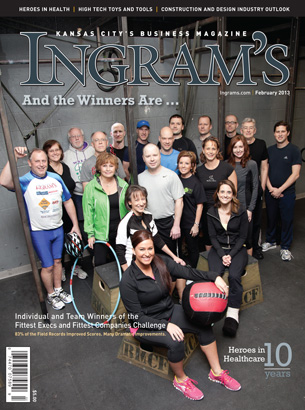Meeting the Challenge
Area execs move to the front lines in the battle for a more fit and healthier work force.
Fittest Team Fittest Individuals Most Improved Teams Most Improved Individuals

Four years of the Fittest Execs and Fittest Companies Challenge have driven home the message that effective workplace wellness programs begin at the top, and that a competitive venue can contribute to greater employee engagement—and thus, a greater return on the organization’s investment.
David Gentile knows all about ROI. He’s CEO of the region’s largest health insurer. But he knows about that return on a more personal level, having donned the work out gear to take part in this year’s Challenge on one of three teams fielded by Blue Cross Blue Shield of Kansas City. “My sense of the way RIO works for individuals is that the team format helped a lot, but it really came down to whether they individually wanted to make a difference. On a personal level, I was using this to get ready for a knee replacement—I needed to be in as good a shape as possible to get through elective surgery.”
Motivation like that is vital to long-term workplace wellness success, he said. So it’s important for anyone structuring such a program to avoid one-size-fits all approaches and understand each employee’s individual motivation—from something as simple as getting into a new swim suit this summer to something more profound, like wanting to live long enough to see a grandchild’s wedding. “Any way you can get the individual to engage and get some ROI is the success,” Gentile said.
The premise of Ingram’s Fittest Execs and Fittest Companies Challenge is simple: Marry C-level commitment with a competitive venue, and you’ve laid the foundation for changing employee behavior. But you don’t get there without breaking a sweat.
That lesson was reinforced throughout the fall and early winter as area executives—and employees from dozens of corporate teams—took up the fourth annual Fittest Execs and Fittest Companies Challenge. It was, statistically speaking, the most successful iteration of the competition since its inception in 2009. This year, a record 83.9 percent of those who finished the competition tested out with higher health scores than when they began, and in many instances, with dramatic results in improved health scores.
That mark was somewhat harder to hit this year because roughly 20 percent of the field was made up of people who had competed in the Challenge in previous years. These were people who had already realized the easiest gains and were working in more rarified territory of higher starting scores.
Organized by Ingram’s and jointly sponsored by BlueKC, the University of Kansas Hospital, The YMCA of Greater Kansas City and Holmes Murphy and Associates, this year’s Challenge introduced a legion of new faces to the competition, in addition to those familiar ones who returned in rare form.
The Fittest Execs and Fittest Companies Challenge is just one, local step toward addressing a much larger national problem with the rising costs of health care and insurance and indicators that the nation’s health overall shows signs of decline. The need to bring health-care costs under control is a burden that falls not just on the nation’s medical-care providers but on individuals’ taking responsibility to improve and maintain their health and their employers’ providing a frame-work for that to happen, business executives say.
Other top area executives joining BlueKC’s David Gentile in the Challenge this year were John Bluford, CEO for Truman Medical Centers, Joe Ratterman, chief executive for BATS Global Markets, Bob Page of University of Kansas Hospital, as well as corporate presidents, chief financial officers and chief operating officers from organizations like Tria Health, Gragg Advertising, A.L. Huber Construction, Panera Bread and many others.
And some organizations went very big: For a second straight year, Stinson Morrison Hecker entered four teams in the Challenge, and Meierotto’s Midwest Jewelers debuted this year with an equal number of teams.
Others, like BATS, Ingram’s Magazine and Gragg Advertising, seized the opportunity to enter one team of fitness buffs in pursuit of the Fittest Team title, and another group of harder health cases to pursue the Most-Improved Team title, so that neither group’s gains were offset by under-perfomers within that category. The outcome? BATS came away the clear winner, grabbing the top corporate spot for Fittest Team, as well as a share of first place in the Most-Improved Team category, and one individual title—Ratterman’s first-place finish for Fittest Man Under 50.
The Challenge, Ratterman said, was an opportunity to place extra emphasis to a goal that was part of the company’s founding in 2005. “We’ve been pushing the message of fitness and health from the very beginning,” he said, so getting involved wasn’t as much a springboard to higher employee awareness of health issues “as much as it was a reaffirmation, or a confirmation, that this is not just something we thought about once—it’s something we think about on a regular basis.”

Analysis: On Average, Nothing About These Gains Was Average
Fittest Execs Challenge All-Time Top 10
2014 Fittest Execs and Fittest Companies Registration Form
Return to Ingram's February 2013